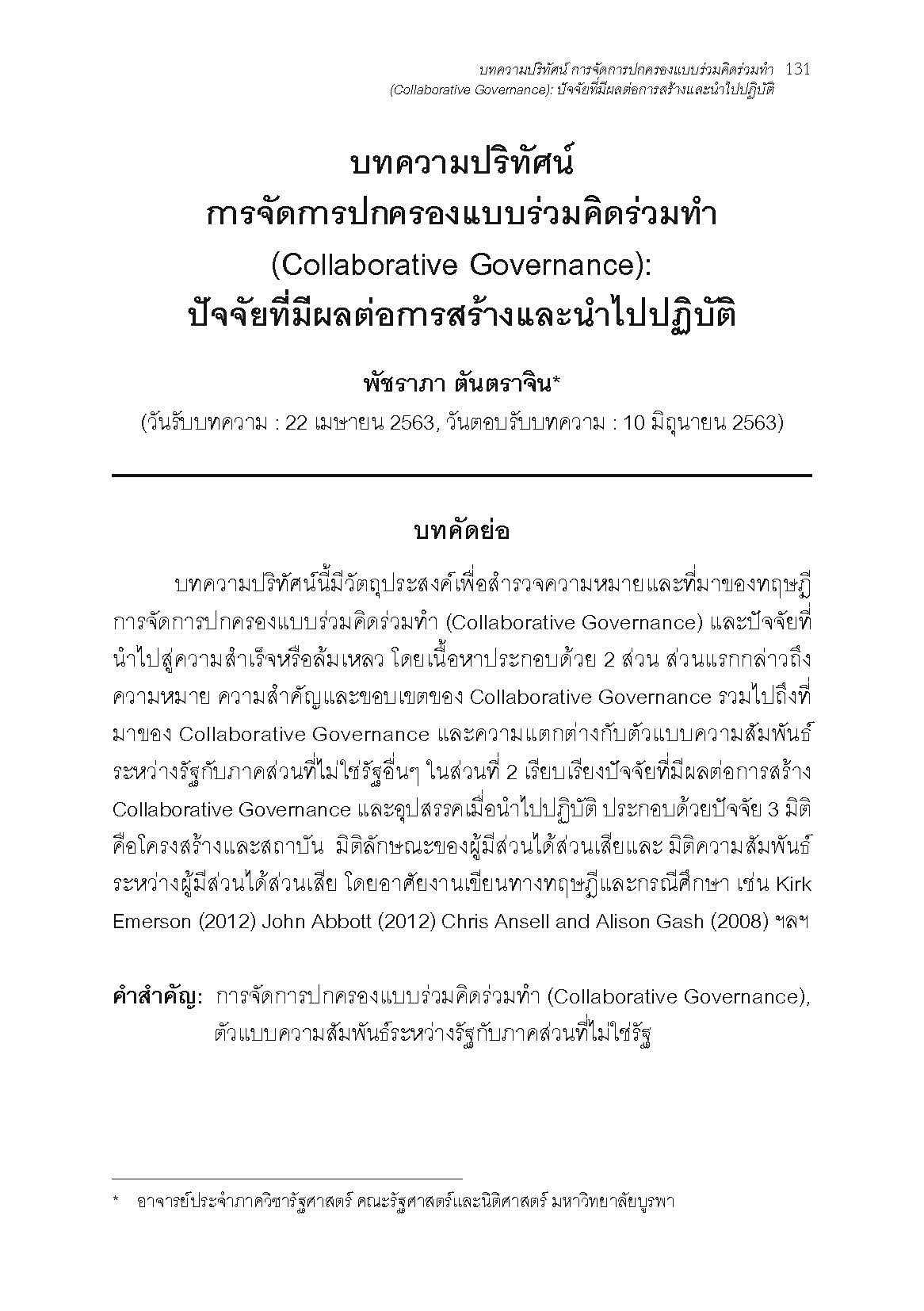Collaborative Governance: Factors affecting its formation and implementations
Keywords:
Collaborative governance, Models of public and non-public sector relationshipsAbstract
The review article explores the meaning and foundation of the theory of collaborative governance and the factors that influence its successes and failures. The first part discusses the meaning, scope, and significance of collaborative governance. It explores its foundation and differences from other models of public and non-public sector relationships. In the second part, the article discusses factors affecting the formation of collaborative governance and factors obstructing its implementation. These factors can be understood through three dimensions: the structural and institutional dimension, the stakeholders’ dimension, and the relationship between stakeholders. The literature review includes the works of Kirk Emerson (2012), John Abbott (2012), and Chris Ansell and Alison Gash (2008), to name only a few.
References
พัชรี สิโรรส และธีรพัฒน์ อังศุชวาล. (2558). เปิดกล่องนโยบายศึกษา (Unpacking policy studies) ว่าด้วยที่มา ที่เป็น และที่ไปของการศึกษานโยบายสาธารณะ. ใน วสันต์ เหลืองประภัสร์, พัชราภา ตันตราจิน, ธีรพัฒน์ อังศุชวาล (บก.). เปิดกล่องนโยบายสาธารณะ: หลากมุมมองในการศึกษานโยบายสาธารณะร่วมสมัย. กรุงเทพฯ: โครงการตำราและสิ่งพิมพ์ คณะรัฐศาสตร์ มหาวิทยาลัยธรรมศาสตร์.
Abbott, J. (2012). Collaborative Governance and Metropolitan Planning in South East Queensland – 1990 to 2010: From a Voluntary to a Statutory Model March 2012. Report for the Australian Centre of Excellence for Local Government (ACELG) in collaboration with the Council of Mayors SEQ and the Queensland Department of Local Government and Planning (Growth Management Queensland). Retrieved March day, 2015, from http://www.acelg.org.au/upload/program1/1332994183_Abbott_Final_ACELG_Report.pdf
Agranoff, R., & McGuire, M. (2003). Collaborative Public Management: New Strategies for Local Governments. Washington, DC: Georgetown University Press.
Ansell, C. & Gash, A. (2008). Collaborative Governance in Theory and Practice. Journal of Public Administration Research and Theory, 18(4), 543-571.
Booher, D. E. (2004). Collaborative Governance Practices and Democracy. National Civic Review. 93(4), 32–46.
Donahue, J. D. & Zeckhauser, R. J. (2011). Collaborative Governance: Private Roles for Public Goals in Turbulent Times. Princeton, NJ: Princeton University Press.
Emerson, K. & Nabatchi, T., & Balogh, S. (2012). An Integrative Framework for Collaborative Governance. Journal of Public Administration Research and Theory, 22(1), 1-29.
Huxham, C. (2000). The Challenge of Collaborative Governance. Public Management, 2(3), 337-357. .
Innes, E. J. (2006). Collaborative Governance in the CALFED Program: Adaptive Policy Making for California Water. Institute of Urban and Regional Development, University of California.
Kapucu, N. & Yuldashev, F., & Bakiev, E. (2009). Collaborative Public Management and Collaborative Governance: Conceptual Similarities and Differences. European Journal of Economic and Political Studies. 2(1), 39-60.
O’Flynn, J. & Wanna, J. (Ed.). (2008). Collaborative Governance: A New Era of Public Policy in Australia?. Australia: ANU E Press.
Pierre, J. & Peters, B. G. (2000). Governance Politics and the State . New York: st. Martin’s Press, Inc.
Sranko, G. R. (2011). Collaborative Governance and a Strategic Approach to Facilitating Change: Lessons Learned from Forest Agreements in South East Queensland and the Great Bear Rainforest. A Journal for and about Social Movements, 3(1), 210 – 239.
Thomson, A. M. & Perry, J. L. (2006). Collaboration Processes: Inside the Black Box. Public Administration Review, 66, S1, 23.
Unger, D. H. & Siroros, P. (2011). Trying to Make Decisions Stick: Natural Resource Policy Making in Thailand. Journal of Contemporary Asia, 41(2), 206-228.



